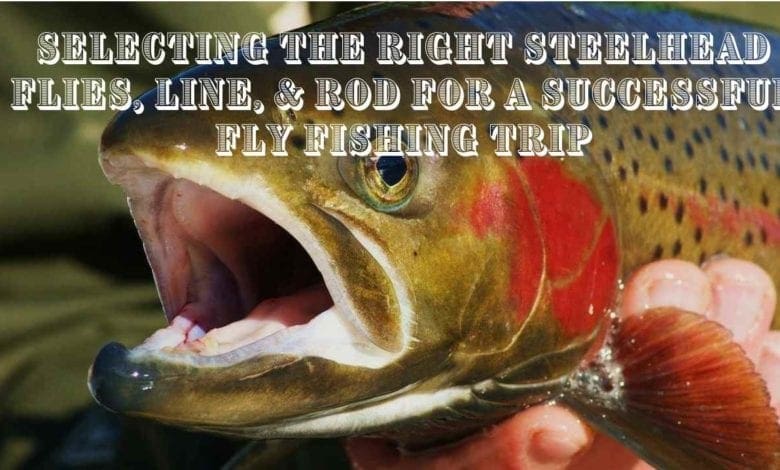How to Select the Right Steelhead Flies, Line, & Rod for a Successful Fly Fishing Trip

Steelhead is a highly-regarded game fish, and one of the most popular fish to catch in the US. Also known as rainbow trout, these majestic cold-water creatures reside in the Northern Pacific Ocean and Great Lakes before migrating to freshwater rivers and smaller lakes. Known for their excellent vision, strength and size, catching steelhead won’t be easy. Whether you plan to catch and release or keep it to eat, having the right rod, line, and steelhead flies can help you land something worth bragging about.
Steelhead Fly Patterns aka Bait or Fly Lures
The key to catching steelhead (or any fish, for that matter) is selecting the right bait. Bait is essentially a lure to trick the fish into hooking onto the line. The more authentic the lure is, the better your chances are of attracting fish. If you’re going to catch rainbow trout, you’ll need to have the right steelhead flies in your tackle box.
When selecting the right steelhead fly patterns, it’s essential to know factors like the water level, temperature and clarity. It also helps to know which flies are native to the area. And if you plan on targeting large “trophy” trout, you’ll need a durable fly that can withstand the power of a fighting fish. The best steelhead flies will fall into four categories; dead-drift (imitation eggs), dead-drift (imitation river invertebrate), action and color response-triggering, or a combination of the other three.
Fly Fishing Line, Backing, Leader & Tippet
Imagine being out on the river for hours trying to catch a steelhead trout. Suddenly, you feel a tug as a fish attempts to eat the steelhead fly. Just as you grab the rod to reel it in, the leader or tippet snaps, and your fish is gone. Just about every first-time angler has found themselves in this position. That’s why you must select the appropriate fly-fishing gear including fly line, backing, leader and tippet.
While there are several fishing lines to choose from, monofilament and fluorocarbon are the most common. As with any gear, you must do your due diligence before making a purchase. Anglers that want to avoid the above scenario must consider factors like the weight, strength, and visibility of the fishing line as well as the kind of tippet and leader.
Fly Rods & Reels
While you could simply select the cheapest or most aesthetically appealing fly fishing rod and reel, that’s not ideal. As with flies and fishing lines, there are certain factors to keep in mind. Let’s start with the fly rod. When figuring out which fishing rod to use, fly anglers should consider action, construction, weight and length.
A fly fishing rod’s action is essentially how the rod moves and flexes when casting the line and catching fish. Action is broken into three categories; heavy, medium and light. When fishing for steelhead trout, a light action rod is ideal as it will be easy to cast your lightweight steelhead fly and be more flexible when the trout becomes airborne.
Graphite and fiberglass are the most common materials used to make fly fishing rods. While either can suffice, graphite rods are lighter and stronger, ideal for catching steelhead trout on the fly. When it comes to the rod’s weight, lighter is also ideal for catching rainbow trout. Last but not least, the longer fly rods are suitable for larger rivers, while shorter rods work best in smaller rivers called tributaries and creeks.
The reel’s purpose is vital to successfully catching rainbow trout. Ultimately, anglers should purchase a reel that accommodates the fly line, backing, and fishing rod weight. It should also have the appropriate drag system to apply enough resistance and speed regulation that will hold up when the trout bites onto your steelhead fly and tries to escape.
There’s no denying that fly fishing steelhead is a pillar of freshwater sport fishing. Ultimately, if you want to improve your success of catching steelhead on the fly, you must equip yourself with the right gear. Whether you’re heading to the Trinity or Klamath river systems in Northern California or to any of New York’s Lake Erie’s tributaries, using the right fly fishing rod, lines, and steelhead fly patterns will help ensure your fishing trip is worthwhile.
